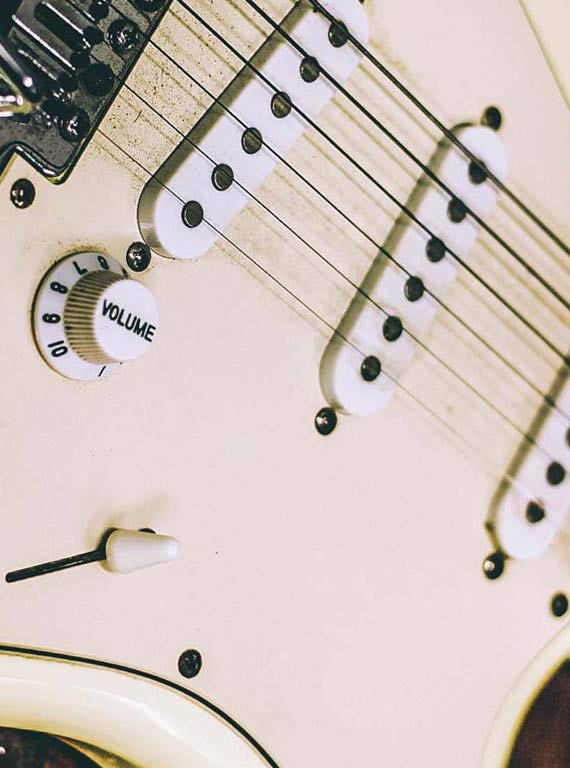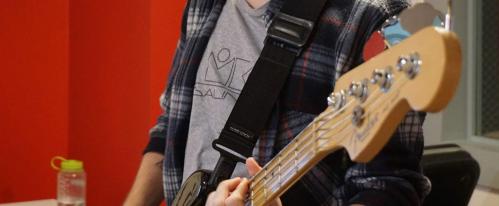Leigh Fuge shows us how to solo in any key on guitar, with one pentatonic scale - including both major and minor scales
We've teamed up with Leigh Fuge at MGR Music to show us how to solo in any key on guitar. In this free guitar lesson we also find out how to solo in major and minor scales using the easy to learn pentatonic scale.
The idea of learning to solo all over the guitar fretboard might seem quite a big task at first, but in this free online guitar lesson we are going to break that down in a way that will make it faster and easier for you to visualise playing lead guitar in any key, any time you want.
Before we get started, we need to learn two main things.
- How to Play a Minor Pentatonic Scale
- The Notes on the Low E string
If you already know these things, then great. If you don’t then check out these videos to get you started with that knowledge:
Below is a video on how to play the C Minor Pentatonic Scale:
The video below show you how to learn the frets on a guitar fretboard:
Once you know these two things we can dive right in.
Soloing in Minor Keys
If we take our minor pentatonic shape in the key of A Minor, we can play that over any A Minor track. This is great to practise with backing tracks or with songs that you already know the key of.
This is the A Minor pentatonic scale. It starts from the 5th fret of the Low E string (Which is an A note).

If the track you are playing over is in the key of A Minor, you can use this scale shape along with your usual licks and technique ideas to form guitar solos. There are backing tracks further down the page.
The great thing with the guitars fretboard layout is that everything you learn is transposable. So, start thinking of this scale shape as a pattern. If we want to shift key, all we need to do is move the shape to a new starting point. This is where knowing the notes on the Low E string is useful.
This image shows us all the notes available to us on the Low E string on the guitar fretboard.

The first note of the scale shape is known as the root note. This is also the note that links up with the key we play in. In the key of A Minor, we root our scale on an A note.
If we want to switch key, we just need to move that root to a new starting point. If you want to solo in the key of C minor for example, you need to move the scale so that the first note is now starting on a C note. With this being transposable, you don’t need to change the shape of the scale or the distances between any notes.

You can see that this is the same shape, but it’s just starting on a C instead of an A.
Whatever other keys you want to solo in, just move the shape to that position. Try this out with some of the backing tracks over on the PMT Youtube channel:
E Minor Backing Track
E Minor Rock Backing Track
G Minor Backing track
C Minor Backing Track
A Minor Backing Track
Soloing in Major Keys
The correct way to play the first shape of the Major Pentatonic scale in the key of A Major is this:

We are going to take these notes and make them resemble the first shape of the minor pentatonic which you should already be pretty comfortable with now. There are 5 different notes here. A, B, C#, E and F#. If we lay them out in a more familiar pattern, we get this:

On first glance, this will look like an F# Minor Pentatonic scale, but the notes inside of this are all from the A Major Pentatonic… strange right?
Let me explain. The major pentatonic is derived from the A Major Scale. The A Major scale is made up of 7 notes that make up the key of A Major:

Each of those notes has a number associated with it, known as an interval. The intervals of the major scale we need for a major pentatonic are I, II, III, V and VI, or, A, B, C#, E and F#.
We can make those notes appear on paper as if they are in a “minor” pentatonic shape, but they are in fact major notes.
The other reason for this is because each key has a “relative” key. F# Minor is the relative minor of A Major. This means the keys of A Major and F# Minor contain all the same notes.
Like the minor pentatonic, you can transpose this around easily. Instead of the first note being the root of the scale, the second note is now the root. If you wanted to play in the key of D Major, you’d need to shift the scale shape so that D is the second note in the scale. This makes it D Major.
The relative minor of D Major is B Minor so on paper this will look like a B Minor Pentatonic.
We hope you enjoyed our free guitar lesson on how to solo in any key!
About the Author:
Leigh Fuge is a professional guitar player and tutor from Swansea in South Wales and a guitar content writer having written and produced content for Guitar Magazine and many other high profile guitar publications and websites.
If you enjoyed this article and video, don’t forget to check out PMT College at the PMTVUK channel on Youtube for more guitar lesson videos.
Professional guidance can make all the difference to your development. Head over to mgrmusic.com and find a great teacher in your local area today. We have a great network of teachers around your local PMT stores including the ones in Birmingham, Cardiff and Newcastle.
About The Author:
This lesson was brought to you by MusicTeacher.com, written by experienced guitar teacher Leigh Fuge. Leigh works as part of a community of guitar teachers based across the UK. This week sees the launch of the Guitar Lessons Sheffield hub. Home of the Arctic Monkeys, Bring Me The Horizon, Pulp and many more famous bands, the Guitar Lessons Sheffield hub will help offer lessons to budding guitarists looking to be the next great rock guitarist. To find guitar teachers local to you, as well as online guitar lessons, simply visit the MusicTeacher.com platform.
If you enjoyed this article and video, don’t forget to check out PMTVUK on Youtube for more guitar lesson videos.







